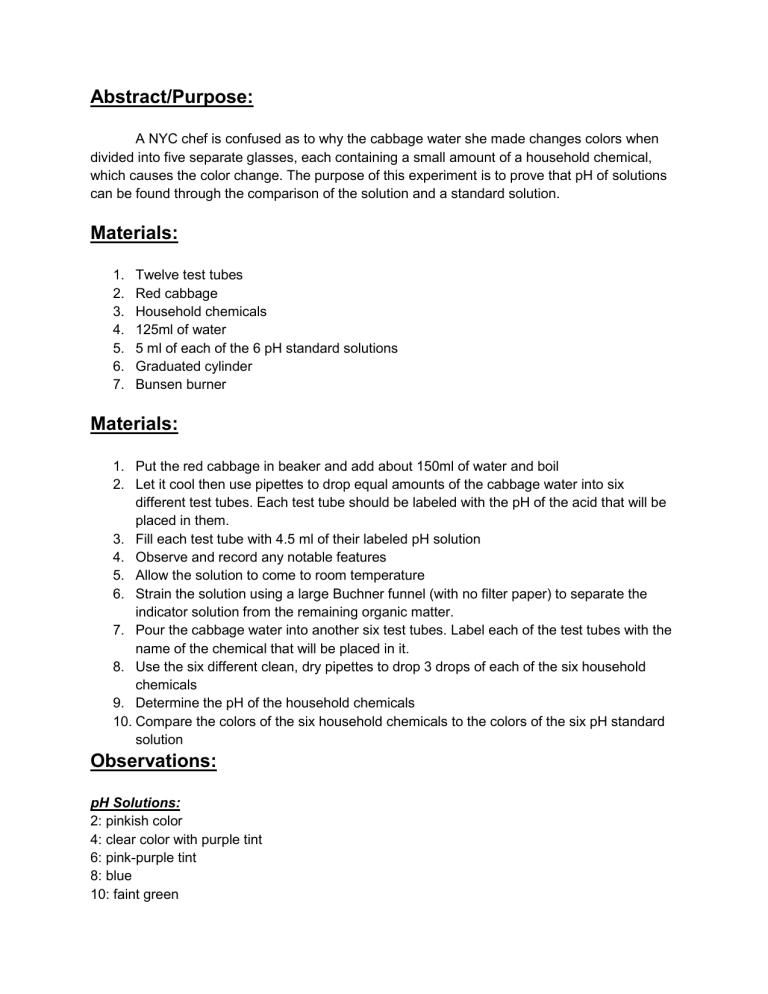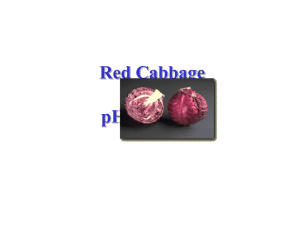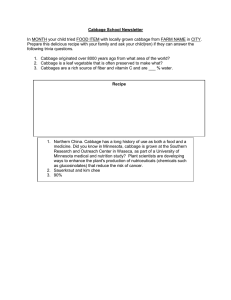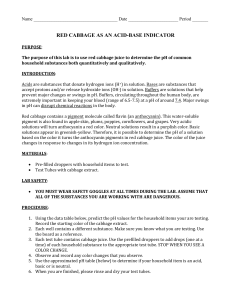
Abstract/Purpose: A NYC chef is confused as to why the cabbage water she made changes colors when divided into five separate glasses, each containing a small amount of a household chemical, which causes the color change. The purpose of this experiment is to prove that pH of solutions can be found through the comparison of the solution and a standard solution. Materials: 1. 2. 3. 4. 5. 6. 7. Twelve test tubes Red cabbage Household chemicals 125ml of water 5 ml of each of the 6 pH standard solutions Graduated cylinder Bunsen burner Materials: 1. Put the red cabbage in beaker and add about 150ml of water and boil 2. Let it cool then use pipettes to drop equal amounts of the cabbage water into six different test tubes. Each test tube should be labeled with the pH of the acid that will be placed in them. 3. Fill each test tube with 4.5 ml of their labeled pH solution 4. Observe and record any notable features 5. Allow the solution to come to room temperature 6. Strain the solution using a large Buchner funnel (with no filter paper) to separate the indicator solution from the remaining organic matter. 7. Pour the cabbage water into another six test tubes. Label each of the test tubes with the name of the chemical that will be placed in it. 8. Use the six different clean, dry pipettes to drop 3 drops of each of the six household chemicals 9. Determine the pH of the household chemicals 10. Compare the colors of the six household chemicals to the colors of the six pH standard solution Observations: pH Solutions: 2: pinkish color 4: clear color with purple tint 6: pink-purple tint 8: blue 10: faint green 12: yellow Household Solutions: Clorox: green Windex: green Soap: faint purple Lemon Juice: pink Vinegar: pink-red Alka-seltzer: pink tint Results: pH of vinegar: 2 pH of lemon juicer: 4 pH of water: 6 pH of soap: 8 pH of windex: 10 pH of bleach: 12 Conclusion: The color change occurred because the bottom of each glass contained a chemical with a specific pH, which reacted with the cabbage water because of the naturally occurring pH indicator, anthocyanin, found in it. Post-Lab Assessment Questions: 1) Sodium hydroxide is a base. 2) When Phenolphthalein is added to 1 M NaHSO4 the resulting solution is colorless. So the pH is below 8.0. When Thymol blue is added to 1 M NaHSO4 the resulting solution is yellow. So the pH is between 2.8-8.2. When Methyl violet is added to 1 M NaHSO4 the resulting solution is violet. So the pH is above 2.0. The result would be between 2.8-7.9 3) Bromothymol blue 4) The solution would be yellow.



